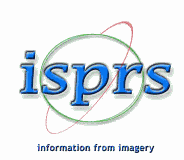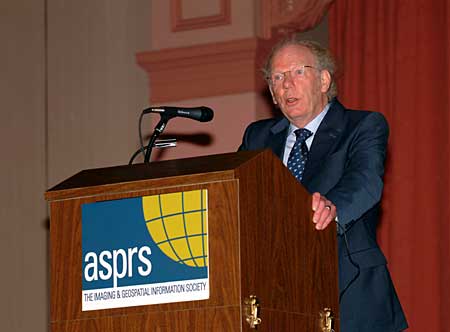|
ASPRS 2006 Annual Conference - A Great Event!
Thirteen workshops, many filled to capacity, were offered on the two days preceding the conference, and covered a wide array of topics including Professional Airborne Digital Mapping Systems - an Overview; Assessing the Accuracy of GIS Information Created from Remotely Sensed Data: Principles and Practices; Remote Sensing of Vegetation; Advanced Topics in Orthophoto Production; and Emerging Technologies in Photogrammetry and Remote Sensing as well as a specially designed workshop for those seeking ASPRS certification. User group meetings were also held on Monday and Tuesday DIMAC, EAGLE Mapping, E. Coyote Enterprises/IGI, ESRI, INPHO, Intergraph, GeoCue Corporation (NIIRS10, Inc.), PCI Geomatics, and RSI. A Plenary session that opened the conference on Thursday, May 4 was presented collaboratively by Darrel Williams, a NASA Landsat 7-Project Scientist, and R. J. Thompson, Chief of the USGS National Center for EROS. They addressed the New Direction for the Landsat Data Continuity Mission. More than 300 technical papers covered many diverse topics including Accuracy Assessments, Wetlands and Forests, Lidar and 3D Studies, Photogrammetry, Feature Extraction, K-12 Education for the Geospatial Sciences, Techniques for Studying Urban Growth, Mapping Invasive Species, and Geohazard Monitoring. Panel discussions included Re-engineering the National Geospatial Programs within the USGS and Developing a Better Fit with the National Spatial Data Infrastructure and Geospatial One-Stop, Licensure & Certification Past, Present and Future, and What is the Future for Remote Sensors? A new format for open discussion of selected topics was introduced at this year's conference. This was held in an open area of the hotel that allowed for participation on an as-desired basis by permitting attendees to join any or all of the six "Hot Topic" areas. The topics discussed were Certification - What's in it for me?, State Licensure, Professional Development and Getting a Job, Lidar-Guidelines, Applications & More, Data Acquisition in Times of Disaster and The Future of Landsat. The participants were encouraged to exchange ideas, problems and solutions they have experienced. This new format was very well received by those attending. It provided for good networking and an opportunity for receptive dialogue. Also introduced at the 2006 conference was the formation of a Student Advisory Council (SAC). Through the SAC, students will have an opportunity to voice their opinions and discuss ways the Society can serve them best. Student input can range from development of a technical session career track for upcoming annual conferences, what books the ASPRS Bookstore should carry, book and software reviews, to a student blog on the ASPRS website. An Exhibit Hall of more than 80 booths showcased the latest in products and services of suppliers worldwide. Exhibit Hall traffic was brisk during the entire conference. Sales of exhibit space at the 2007 Annual Conference in Tampa were vigorous on the last day of the conference indicating the success of this year's event. The ASPRS tradition of honoring members who have contributed greatly to the field and to the Society continued this year with a Memorial Address for David S. Simonett. Dr. Simonett achieved prominence in the field as Chairman of the Geography Department at the University of California Santa Barbara. Dr. Stanley Morain presented the highlights of his life. Numerous awards were made throughout the conference to many deserving recipients including two new Honorary Members, three ASPRS Fellows, student scholarships, and ASPRS Region awards. Several social events rounded out this stellar conference for 2006, including the Exhibitors' Reception on May 3 and An Evening at the National Automobile Museum on May 4. Founded in 1934, ASPRS is an international professional organization of 6,000 geospatial data professionals. ASPRS is devoted to advancing knowledge and improving understanding of the mapping sciences to promote responsible application of photogrammetry, remote sensing, geographic information systems and supporting technologies. For additional information about ASPRS, visit our web site at www.asprs.org.
|
|
|
|
|

 The ASPRS 2006 Annual Conference was held May 1-5 at the Reno Hilton Hotel, Reno, Nevada with nearly 1400 attendees. This year's conference, Prospecting for Geospatial Information was opened with a keynote address delivered jointly by Stephen K. Robinson, PhD, NASA Astronaut and Donn Liddle with Muniz Engineering. Their presentation, "Inspecting the Space Shuttle in Flight using Photogrammetric and Remote Sensing Technology," captivated the audience as they described how photogrammetry played a crucial role in determining the seriousness of damage to the thermal tiles on the last Space Shuttle mission.
The ASPRS 2006 Annual Conference was held May 1-5 at the Reno Hilton Hotel, Reno, Nevada with nearly 1400 attendees. This year's conference, Prospecting for Geospatial Information was opened with a keynote address delivered jointly by Stephen K. Robinson, PhD, NASA Astronaut and Donn Liddle with Muniz Engineering. Their presentation, "Inspecting the Space Shuttle in Flight using Photogrammetric and Remote Sensing Technology," captivated the audience as they described how photogrammetry played a crucial role in determining the seriousness of damage to the thermal tiles on the last Space Shuttle mission.